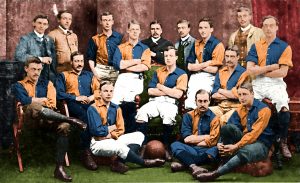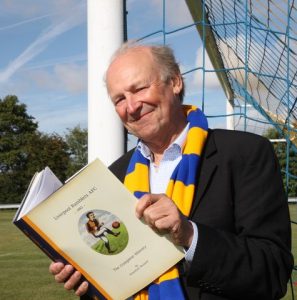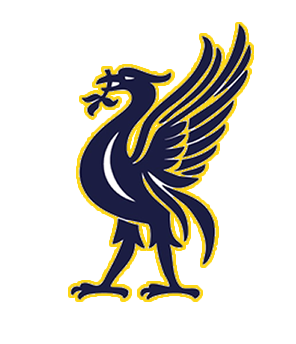
Researching for ‘The Complete History of LRAFC’
A coincidence causes surprise. Multiple coincidences relating to the same subject go past initial surprise, to amazement and then to an unsettling feeling that it is getting out of control, and eventually to question if someone out there is trying to send a message!
On the day I first entered the old Ramblers clubhouse, in December 1963 to play in the schoolboy trials, I noticed a framed black and white photograph behind the bar of the first Ramblers team of 1883. It was interesting but I never gave it much thought, never wondered whose those men were until I started to research the history, not of the world’s greatest football club, but of the world’s greatest club that plays football. (That’s a slight paraphrase of how LRAFC was aptly described by a past President in the 1960s). I naturally returned to that photograph, and the stories behind those Ramblers are in the Book. But there was one figure who intrigued me more than the rest, Bruce Ismay, because of his connection to the drama of the Titanic.

The 1883 Liverpool Cup Final photo which I had a specialist graphic artist convert from the original black and white image which sat behind the Ramblers bar from time immemorial. Orange and navy blue were the original colours. Bruce, dark haired and in white knickerbockers is standing on the right of the suited person with a black and white cravat. I wasn’t certain whether Arthur Midwood, in white shorts (standing on the other side of the captain next to the man in a black coat) had been to Eton. I phoned the family home. A grand lady answered and I enquired if Arthur had been to Eton like the rest of the family as the relevant register was missing. There was a long silence followed by the words “Of course he went to Eton, where else could he possibly have gone. Good day to you”. That was enough evidence for me!
There was an interesting story to be told about Bruce, as I started to research him and the Titanic (which is in the first chapter). It seemed amusing we were both left backs and our careers had been in shipping with Liverpool-based companies. He of course was a shipowner, thanks to the entrepreneurship of his grandfather who is buried in the largest tomb in the graveyard of Thurstaston church. Thomas Ismay, had built a large ‘dark, forbidding house’ on the nearby Dawpool estate in 1882 – the same year as my grandfather (also a shipowner and Liverpool Rambler) was born and the year Liverpool Ramblers AFC was formed. Bruce Ismay lived in this house which was eventually demolished in 1927 and the estate broken up into 3 lots. In the 1960s my father bought one of those plots of land, close to the original gates and lodge, and built a home. Sadly, I never made the connection at that time.

Dawpool country house ‘stark and grim’. Thomas Ismay used his influence to ensure that the West Kirby – Hooton railway was routed a mile away along the Dee Estuary, rather than closer to the village. He was also successful in moving the main Heswall to West Kirby road, which came too close to the doorstep of his mansion, via a cutting through Thurstaston Hill.
In London, while starting to write the book, I often walked our black Labrador on Wimbledon common and down the lane beside Putney Vale cemetery. There was one tomb which stuck out close to the railings and, having wondered many times whose it was, I went one day to find out. I was taken aback. It was Bruce Ismay’s final resting place along with a note, wrapped in cellophane and attached to a stick with a union jack flag, on which was written ‘To Bruce Ismay. Be proud of Titanic. The truth will set you free.’ Having lived 100 yards from where he had lived in Thurstaston, his burial tomb is half a mile from where I live now.
Then in 2012, to mark the centenary of the Titanic disaster, Frances Wilson published a fascinating history of Bruce Ismay and the events of the Titanic’s sinking. On page 227 I was astonished to read that on the Titanic he saved the life of a fashion journalist by insisting she got into a lifeboat. She claims they later became more than just good friends. Her name was Edith Russell. This was a spooky moment. I am not aware I am related, but it was at this point I asked Bruce Ismay to please desist from any more coincidences!
Frances Wilson wrote of Ismay as being a loner, not happy to mix in company. I emailed her and pointed out that Ismay had been one of the founding members of the Ramblers, and if he had not been a collegiate person he would not have been accepted. The same camaraderie spirit that has existed within the Ramblers membership over the last 60 years was the same in 1882, perhaps not surprising then as they were 99% Old Etonians and Harrovians. She had no idea about his Ramblers life, nor that he was a commanding presence on the football field.
On a happier note, while recently researching for a chapter for a book on Shrewsbury School’s contribution to Football in the 19th century, I came across a newspaper report of the Ramblers match against the School in 1884 in which Bruce Ismay was the star Rambler player.

Yesterday I found this link to her book in full on the internet. It really is worth a read about, arguably, the most interesting member in the history of the Ramblers. https://www.you-books.com/book/F-Wilson/How-to-Survive-the-Titanic
Finally, those of you who have managed to get past the foreword and to the start of the first chapter of The Book will have seen an 1876 photo of a group of smartly dressed boys, including Arthur Keeley who created Bootle St John’s which led to the start of LRAFC. I now know the background of all those St John’s College, Cambridge footballers which I will reveal next time. In the meantime, to know St John’s gave Keeley his love for football, and for the last 50 odd years we have been playing the same college, out of all the Oxbridge colleges. Now that is a coincidence!

Jo Russell
